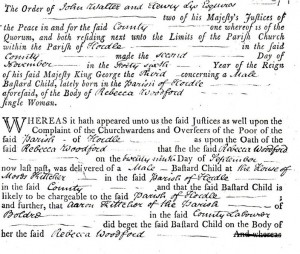…. illegitimacy. Back when we have only parish registers to rely on for our family and local history research, comments such as ‘base’, ‘bastard’, or simply a capital B are recorded to indicate that a child was born out of wedlock. Sometimes only the mother’s name is noted on the baptismal register and on other occasions, the two parents are referred to with differing surnames. The same is true of birth certificates, issued since civil registration began on 1 July 1837.
Illegitimacy rates were not high during the early modern period. At their highest between 1590 and 1610, rates reached three per cent. Pre-marital pregnancy was common, certainly in the seventeenth to nineteenth centuries, and many illegitimate births were probably the result of abandoned or delayed marriage plans. Rates were highest in the second quarter of the nineteenth century, reaching a high point of seven per cent but then gradually declining to four per cent by the 1890s.
Our forebears placed great emphasis on the bonds of marriage, and those who deviated from this social norm faced condemnation from their community.
Before 1834, it was the responsibility of the local parish to pay upkeep for an illegitimate child, so the parish would go after the father to seek maintenance, which created bastardy bond documentation for some illegitimate offspring.
For example, the churchwardens and overseers of the poor for the parish of Hordle in 1805, document the male bastard child of Rebecca Woodford and the reputed father, Aaron Kittcher:

42M75/PO5/9 Aaron Kittcher of Boldre: Rebecca Woodford, delivered of a male child 29 Sep 1805 at the house of Moses Kittcher; order made 2 Nov 1805
Such was the shame of illegitimacy that families often went to great lengths to keep their guilty secret under wraps – making the task of modern family and local historians all the more difficult.
As it can be almost impossible to uncover a child’s true paternity, seemingly circumstantial evidence should not be overlooked. Naming practices can provide clues. For example, a surname given as a middle name could be the father’s surname. Look closely at the address where the baby was born, too: it may be a mother and baby home or a workhouse, which might have records you can look at.

